Framingham Legends & Lore (19 page)
Read Framingham Legends & Lore Online
Authors: James L. Parr

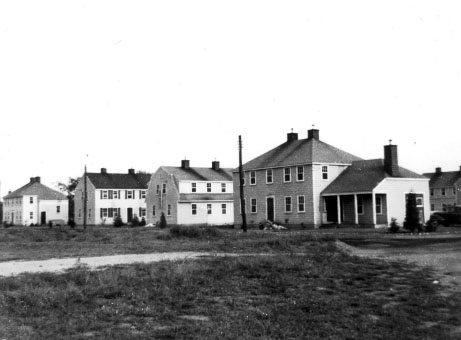
World War II barracks built to resemble neighborhood homes.
Courtesy of Carl J. Loftesness
.
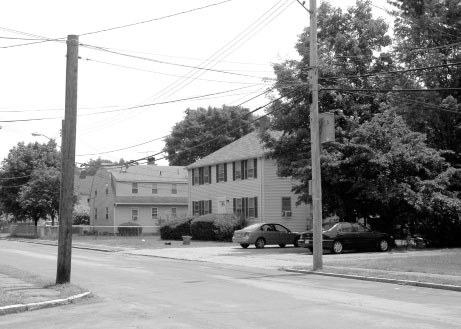
The same view today.
Photo by Edward P. Barry
.
Off-duty soldiers walked through the army woods to swim in Learned's Pond just as volunteers from the Massachusetts Militia had done decades before them. The walls of the church/theatre were decorated with a mural of scenes from Framingham history, and the soldiers were entertained with movies and occasional live performances by celebrities such as comedian Milton Berle and Bela Lugosi, star of the 1931 movie
Dracula
. The bulletin board in the mess hall was filled with notices placed there by Framingham families inviting the young soldiers to a home-cooked meal with a friendly family. The battalion stayed in Framingham until September 1943, when they shipped out and eventually made their way to the Pacific theatre, serving with distinction in Guam and the Philippines.
A N
EW
L
IFE FOR THE
O
LD
M
USTERFIELD
After the war, both the town and the state developed much of the old Musterfield property for a variety of purposes. Many of the original army barracks were remodeled as single-family homes and used as veterans' housing, while additional apartments were built to ease the postwar housing shortage. On Concord Street, War Memorial Park was dedicated in 1952 to all of the soldiers from town that had fought in the nation's wars, beginning with the Revolution. The focal point of the park is a sculpture of Freedom by Boston sculptor Emilus Ciampa. Across from the park the Middlesex District Courthouse was built. The National Guard maintained its presence in the area when it built a new armory on the former site of the commandant's house. New streets were laid out and named after significant battles of World War II. The battles of Corregidor in the Philippines, Oran in Algeria, Guadalcanal in Japan, Anzio in Italy, Normandy and St. Lo in France and Pearl Harbor in Hawaii are all memorialized in the streets of the neighborhood that is still known as the Musterfield. Another new street, Flagg Drive, was named after Framingham High graduate Charles Flagg, who was killed at Iwo Jima. The multipurpose church/theatre would have a new life as an actual church many miles away from Framingham. After a devastating fire ripped through the Brant Rock section of Marshfield, Massachusetts, in 1941, the parishioners of St. Ann's by-the Sea were left without a church. Arrangements were made to transport the former Camp Framingham building to Marshfield, where it was used for services for ten years until a new church was built. Today it still stands and is used as the parish center.
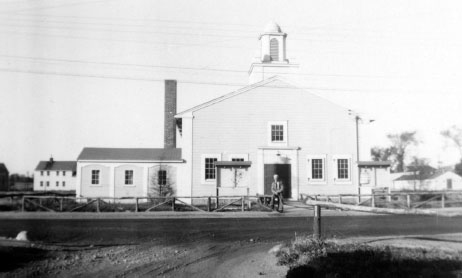
The World War IIâera theatre/church at the Musterfield.
During the Cold War, the same fears of enemy attack that had earlier prompted army barracks to be disguised as neighborhood homes during World War II brought about the development of the State Emergency Operations Center (SEOC), commonly known as “The Bunker.” Operated today by the Massachusetts Emergency Management Association (MEMA), the bunker was dedicated on November 16, 1963. The underground bunker was built as a headquarters for state government in case of nuclear attack. Covering nearly an acre of land on Route 9, the bunker is equipped with enough food, water, medical supplies and emergency air supply for three hundred people to survive for thirty days without outside aid. It is built of reinforced concrete with steel blast doors designed to withstand a twenty-megaton bomb blast.
The former parade ground has changed the least since the days when young men trained and drilled there in decades past. It is now used as an athletic field and was named after Framingham teacher, coach and athletic director Frank Galvani.
C
USHING
H
OSPITAL
Across town, American soldiers were welcomed to Framingham under vastly different circumstances than at Camp Framingham. Cushing Hospital was opened as a military hospital in January 1944 and was quickly occupied by hospital staff and the many wounded soldiers under their care. Named for accomplished army surgeon and medical pioneer Dr. Harvey Cushing, the huge complex occupied over one hundred acres across from Farm Pond. The first large influx of wounded soldiers to arrive at the hospital came with the D-Day invasion of France in June 1944. Over the next few years, almost fourteen thousand soldiers were cared for at the facility.
Long after the war, a group of secret documents was declassified by the government, and a curious incident at Cushing was brought to light. The nonmedical staff of the hospital during the war was primarily made up of local women who worked in the kitchens and laundry rooms of the huge complex. But the outside maintenance of the facility was done by German and Italian prisoners of war, who were transported from the stockade at nearby Fort Devens. In December 1944, an inspector from the U.S. Army Counter Intelligence Corps arrived at Cushing to investigate reports of fraternization between civilian female kitchen employees and POWs. Witness interviews revealed that several of the women had fallen in love with several of the POWs, leaving them love letters and gifts such as a hairbrush kit purchased at the hospital's Post Exchange. One witness claimed to have overheard a coworker remark about a particular German prisoner, “He can put his shoes under my bed any night.” Although investigators interviewed several witnesses and took fingerprints off the hairbrush kit, they apparently did not find the evidence reliable enough to pursue the matter further, and the investigation was dropped.
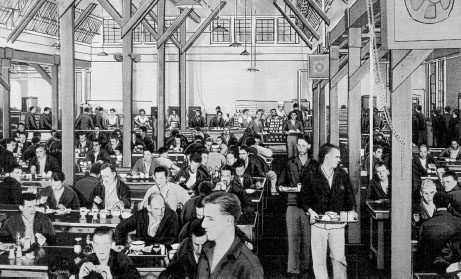
Mess hall at Cushing Hospital.
After the war, the facility served first as a veterans' hospital before the Korean War put it back in the business of taking wounded soldiers from the New England region. On July 26, 1951, General Douglas MacArthur, who had recently been dismissed by President Harry S. Truman from his command of the forces in Korea, made a visit to Framingham, including a stop to visit the patients at Cushing. Helen Keller was yet another distinguished visitor during this era.
By the late 1950s, Cushing was briefly mothballed before becoming a state hospital for the elderly. Thirty acres were set off for use by the town for the Barbieri Middle School in the 1970s. The hospital was finally closed for good in 1991 by the state, and another thirty acres of the original property were developed as an assisted living facility. The rest of the grounds are maintained by the town as parkland. The only significant building remaining from the original hospital complex is the chapel, which was saved after vigorous lobbying by local groups. The chapel was renovated and rededicated in 1999 and is still used for weddings and funerals.
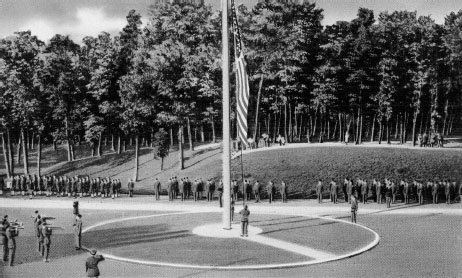
Flag ceremony at Cushing Hospital.
F
RAMINGHAM
S
INCE
W
ORLD
W
AR
II
The last sixty years have brought new challenges and opportunities to Framingham. Downtown's economic base has faded since the 1950s, with the general decline of American manufacturing and the loss of the two biggest employers, Dennison and General Motors. The department stores and shops of downtown vanished long ago as well.
Yet the story of Framingham since 1945 has not been one of decline. Just as in the nineteenth century, Framingham's central location and status as a transportation hub remains unchanged. The construction of the Massachusetts Turnpike in the 1950s opened the town up as a home for commuters to Boston, or to the thriving companies along the Route 128 beltway. The town's population, which stood at 23,214 in 1940, shot up to 64,048 by 1970 as the northern half of the town especially was filled with brand-new ranch homes housing the young families creating the postwar baby boom. Route 9 became a retail mecca, with the opening of Shopper's World, the first modern shopping mall east of the Mississippi, in 1951. Even as manufacturing has ebbed, new companies such as Staples, Bose and TJX clothing retailers located their headquarters here. Even the downtown, in definite decline by the 1970s, was revived by a new influx of Brazilian immigrants, so that by the late 1990s it was as unusual to see a vacant storefront on Concord Street or Union Avenue as it was to see a building without a Brazilian flag draped in a least one window.
The changes the twenty-first century will bring to Framingham have yet to be seen. Will the recent crackdown on illegal immigration rob downtown of its vitality and return it to the dark days of the 1970s? Or will it be replaced by a new energy from an as yet unknown source?
AFTERWORD
What is it that elevates a historical incident from documented fact to folklore? Perhaps it is the passage of timeâthe most recent stories in this narrative took place shortly after World War II. Another factor may be the odd, sometimes circumstantial connection these stories have to the better-known names and events of American history. Good folklore contains a healthy amount of triviality, mystery, humor, exaggeration and quirkiness. Another characteristic of legends born from fact is the disappearance of the context in which the episodes took place. Everyday events achieve mythical status when their settings have been torn down or modernized and the social customs and beliefs of the day have drastically changed. It is difficult to picture a vast, shady outdoor amphitheatre, filled with proper Victorian families enjoying a temperance lecture, while standing near the town incinerator that now occupies the site.
